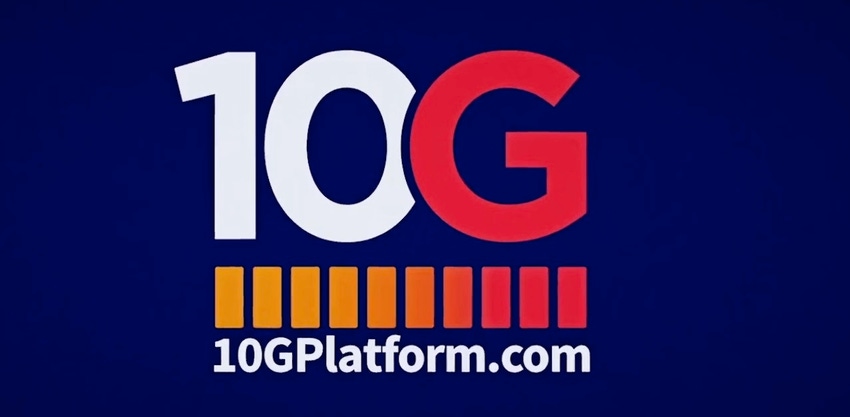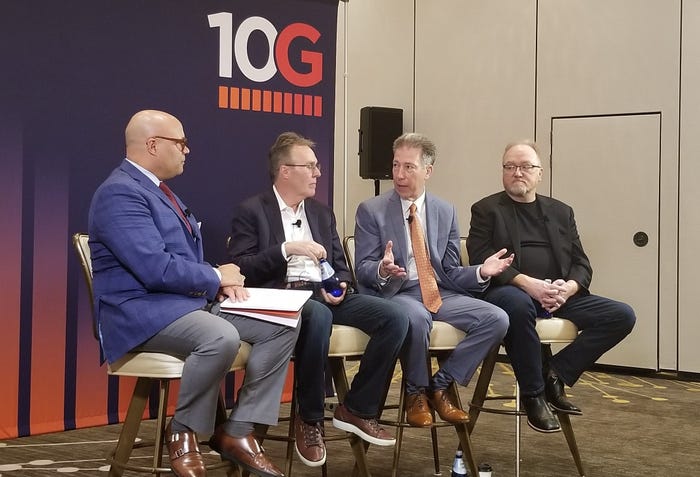Cable's '10G' journey makes progress… with a few bumps along the way
The cable industry unfurled its '10G' initiative five years ago at CES. CableLabs is touting some cable milestones achieved since, but the industry's 10G journey hasn't always been smooth sailing.

Five years ago at CES in Las Vegas, the cable industry took a big, unified step forward by unveiling a new initiative focused on delivering symmetrical 10-Gig speeds along with enhanced security, lower latencies and improved network and service reliability.
Amid the hype surrounding 5G and the threats being posed by fiber competition, execs from CableLabs, Comcast, Cox Communications and NCTA – The Internet & Television Association gathered at the Four Seasons to discuss the plans and aims of that initiative, branded "10G."
The underpinnings of 10G were based on technologies that were already being proved out in the lab, they said.

Cable introduced its '10G' initiative at CES 2019. Pictured (from left to right): NCTA President and CEO Michael Powell; former Comcast exec Tony Werner; former Cox President Pat Esser; and CableLabs President and CEO Phil McKinney. (Source: Jeff Baumgartner/Light Reading)
Initial discussions about 10G centered on Full Duplex (FDX) DOCSIS, a technology that started out as an extension to DOCSIS 3.1 and was later included in the new DOCSIS 4.0 specifications. "Nothing new has to be invented," Phil McKinney, CEO of CableLabs, said at the time. "The technical risk is near zero to get from 1-Gig to 10-Gig."
"This will work," Tony Werner, then president of Comcast Cable's Technology, Product, Xperience group, said.
It was later clarified that 10G wasn't solely about boosting the capabilities of widely deployed hybrid fiber/coax (HFC) networks but rather an initiative focused on a "collection of technologies" that included fiber-to-the-premises (FTTP) and wireless access networks.
Since then, the cable industry has made some significant strides towards 10G's goals. They include a mix of trials and initial deployments of DOCSIS 4.0, cable's targeted use of PON, some momentum around low latency DOCSIS, and the use of AI tools and network virtualization to improve network performance and reliability.
But the road to 10G hasn't always been smooth. Bifurcation within DOCSIS 4.0, which supports two options (the aforementioned FDX as well as Extended Spectrum DOCSIS, or ESD), Broadcom's insistence on joint development agreements in exchange for access to its new D4.0 tech, and lawsuits between two key players have muddied the path forward.
CableLabs highlighted a few milestones to commemorate the fifth anniversary of the public launch of the 10G initiative, pointing to the issuance of its coherent PON architecture specs and a new laser-focus on FTTP tech adoption via the launch of a pair of new working groups. It also highlighted 10G-focused work underway by several cable operators, including Comcast, Cox Communications, GCI, Midco and Mediacom Communications and VodafoneZiggo/Liberty Global.
Suppliers have submitted modems for official DOCSIS 4.0 certification testing
CableLabs is also progressing with its DOCSIS 4.0 testing capabilities. It hosted a pair of interoperability events in 2023, the latest one focused on security, and announced last June that its Kyrio subsidiary is ready to accept products for official DOCSIS certification testing.
Delivering symmetrical, multi-gig speeds remains a "big part of the overall target" for 10G, Mark Bridges, CableLabs' new CTO, tells Light Reading. But CableLabs and the industry at large are now starting to emphasize the platform's other "pillars" of low latency, security and reliability, he said.
Bridges noted that this reliance and performance work is also being applied not just to DOCSIS but to optical technologies as well as Wi-Fi.
Bridges said that the organization has a "pretty aggressive schedule" for conducting D4.0 interops during the first half of 2024, including one coming up soon that will focus on proactive network maintenance (PNM). From there, CableLabs hopes to shift more attention toward the interoperability of various other DOCSIS 4.0 components for both FDX and ESD.
The exec also confirmed that CableLabs has received its first product submissions for official DOCSIS 4.0 modem certification testing. Those haven't been announced and will likely not be revealed until one of those products gets a passing grade. But it's possible that the initial set of products being submitted are powered by new D4.0 silicon from Broadcom that Comcast is already deploying. MaxLinear expects that its D4.0 modem chip, the Puma 8, will become available later this year. A MaxLinear official said the company will submit a reference platform for certification.
Progress with low-latency
Another area of emphasis is Low Latency DOCSIS (LLD), a feature that has been bridged from DOCSIS 3.1 to DOCSIS 4.0. Comcast is testing LLD with an eye toward deployment sometime in 2024.
Bridges said LLD is part of CableLabs' overall interop testing along with some work focused on the Internet Engineering Task Force's Low Latency Low Loss Scalable Throughput (L4S) standard. He said CableLabs is also exploring ways to apply low-latency techniques to Wi-Fi and make recommendations to Wi-Fi standards organizations.
"It's pretty early days," he said. "We're exploring what we think is possible, what we think is feasible... and then start to make recommendations after that."
On the security side, CableLabs recently introduced a Custom Connectivity project designed to provide a secure connection for specific services – such as dedicated bandwidth, latency, flexible payment options and other features – to individual gateways and access points. One use case involves delivering dedicated services to individual units within a multiple dwelling unit, Bridges said.
CableLabs' first proof-of-concept for Customer Connectivity is underway in Panama, where Liberty Latin America and Veea are focused on bringing services to relatively unserved or underserved people in dense, "unbanked" communities.
A few wrinkles
There's no doubt that the cable industry has made progress on 10G over the past five years and shown a degree of collaboration and collegiality around the project, but it hasn't always been smooth sailing.
One of the biggest issues has been DOCSIS 4.0's aforementioned bifurcation. Comcast has been laser-focused on FDX, while much of the rest of the industry has looked toward the ESD option. Those multiple options fueled industry confusion early on and played a role in delaying the progress of DOCSIS 4.0 tech development as well as operator commitments to the platform.
A potential remedy is a new set of "unified" modem, amplifier and node chips from Broadcom (in collaboration with Comcast) that support both FDX and ESD. While that could bridge the gap between those two options, access to the new chips is initially limited to operators that have signed a joint development agreement (JDA) that, according to industry sources, can cost up to $20 million. Broadcom has pledged to open up access beyond those who have signed the JDA, but has declined to say when that will occur.
MaxLinear, Broadcom's rival in the DOCSIS silicon arena, is currently focusing on D4.0 chips that support ESD that aren't encumbered with a JDA.
There's no telling if MaxLinear will eventually go the unified route and also add support for FDX.
MaxLinear and Comcast are fighting in the courts. Those battles include recent counterclaims by MaxLinear alleging that Comcast stole its FDX ideas and then hired Broadcom to commercialize the technology. Comcast, which is suing MaxLinear for breach of contract, denies the accusations.
Cable's 10G initiative also has run into some static in the advertising world. Earlier this year, an ad industry watchdog recommended that Comcast drop or alter the use of "10G" in its broadband-focused advertising following complaints raised by Verizon and T-Mobile.
Meanwhile, it's not entirely clear if the full heft of the cable industry will upgrade to DOCSIS 4.0 anytime soon.
While Comcast and Charter Communications are among some top US operators with relatively clear D4.0 goals, there's growing interest among operators in beefing up downstream speeds by deploying D4.0 modems on D3.1 networks or taking advantage of new, upgraded DOCSIS 3.1 modems that support additional OFDM (orthogonal frequency-division multiplexing) channels.
Broadcom is said to be working on a new D3.1 chip called the BCM3392 that supports four 192MHz-wide OFDM channels, doubling what's supported in Broadcom's current-gen BCM3390 D3.1 chip.
Last week, MaxLinear announced that an "ultra" DOCSIS 3.1 version of its Puma 8 chip doesn't include the upstream enhancements needed for a full-blown DOCSIS 4.0 modem. That option, which supports five OFDM downstream channels, has demonstrated downstream speeds of greater than 10 Mbit/s on a DOCSIS 3.1 network, MaxLinear said.
Those developments could put some operators in a position to deliver fiber-like speeds (at least in the downstream direction) without having to implement a full D4.0 network upgrade or maybe put off the need for those upgrades.
Boiled down, this all means that there's not one, but many, roads to 10G – or at least something close to it.
Avoiding the fate of tru2way
But it also appears that cable's 10G initiative, despite a few bumps, will fare much better than tru2way.
Introduced by the cable industry at CES 2008, tru2way was billed as the consumer brand for retail-ready interactive set-tops and TVs that used the CableLabs-specified OpenCable Application Platform (OCAP).
It had some successes, including temporary adoption by Panasonic for a small range of HDTV models and developing a portable DVR that resembled a George Foreman Grill that never was commercially deployed. Eventually, tru2way flamed out after cable failed to convince the broader CE industry to get behind it.
About the Author(s)
You May Also Like





.jpg?width=300&auto=webp&quality=80&disable=upscale)






